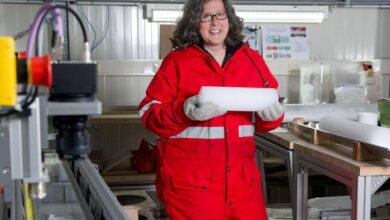This Startup’s AI Tool Makes Moving Day Easier

Engineers are used to being experts in their field, but when Zach Rattner cofounded his artificial-intelligence startup, Yembo, he quickly realized he needed to get comfortable with being out of his depth. He found the transition from employee to business owner to be a steep learning curve. Taking on a host of unfamiliar responsibilities like finance and sales required a significant shift in mind-set.
Rattner cofounded Yembo in 2016 to develop an AI-based tool for moving companies that creates an inventory of objects in a home by analyzing video taken with a smartphone. Today, the startup employs 70 people worldwide and operates in 36 countries, and Rattner says he’s excited to get out of bed every morning because he’s building a product that simply wouldn’t exist otherwise.
Zach Rattner
Employer:
Yembo
Occupation:
Chief technology officer and cofounder
Education:
Bachelor’s degree in computer engineering, Virginia Tech
“I’m making a dent in the universe,” he says. “We are bringing about change. We are going into an industry and improving it.”
How Yembo grew out of a family business
Rattner has his wife to thank for his startup idea. From 2011 to 2015, she worked for a moving company, and she sometimes told him about the challenges facing the industry. A major headache for these companies, he says, is the time-consuming task of taking a manual inventory of everything to be moved.
At the time, he was a software engineer in Qualcomm’s internal incubator in San Diego, where employees’ innovative ideas are turned into new products. In that role, he got a lot of hands-on experience with AI and computer vision, and he realized that object-detection algorithms could be used to automatically catalog items in a house.
Rattner reports that his clients are able to complete three times more inspections in a day than traditional methods. Also his customers have increased their chances of getting jobs by 27 because they’re able to get quotes out faster than the competition, often in the same day.
“Comparing Yembo’s survey to a virtual option like Zoom or FaceTime, our clients have reported being able to perform three to five times as many surveys per day with the same headcount,” he says. “If you compare us to an in-house visit, the savings are even more since Yembo doesn’t have drive time.”
Getting used to not being an expert
In 2016, he quit his job to become a consultant and work on his startup idea in his spare time. A few months later, he decided the idea had potential, and he convinced a former Qualcomm colleague, Siddharth Mohan, to join him in cofounding Yembo.
Rattner admits that the responsibilities that come with starting a new business took some getting used to. In the early days, you’re not only building the technology, he says, you also have to get involved in marketing, finance, sales, and a host of other areas you have little experience in.
“If you try to become that rigorous expert at everything, it can be crippling, because you don’t have enough time in the day,” Rattner says. “You just need to get comfortable being horrible at some things.”
As the company has grown, Rattner has become less hands-on, but he still gets involved in all aspects of the business and is prepared to tackle the most challenging problems on any front.
In 2020, the company branched out, developing a tool for property insurers by adapting the original AI algorithms to provide the information needed for an accurate insurance quote. Along with cataloging the contents of a home, this version of the AI tool extracts information about the house itself, including a high-fidelity 3D model that can be used to take measurements virtually. The software can also be used to assess damage when a homeowner makes a claim.
“It feels like it’s a brand-new startup again,” Rattner says.
A teenage Web developer
From a young age, Rattner had an entrepreneurial streak. As a 7-year-old, he created a website to display his stamp collection. By his teens, he was freelancing as a Web developer.
“I had this strange moment where I had to confess to my parents that I had a side job online,” he says. “I told them I had a couple of hundred dollars I needed to deposit into their bank account. They weren’t annoyed; they were impressed.”
When he entered Virginia Tech in 2007 to study computer engineering, he discovered his roommate had also been doing freelance Web development. Together they came up with an idea for a tool that would allow people to build websites without writing code.
They were accepted into a startup incubator to further develop their idea. But acceptance came with an offer of only US $15,000 for funding and the stipulation that they had to drop out of college. As he was writing the startup’s business plan, Rattner realized that his idea wasn’t financially sustainable long term and turned the offer down.
“That is where I learned there’s more to running a startup than just the technology,” he says.
This experience reinforced his conviction that betting everything on one great business idea wasn’t a smart move. He decided to finish school and get some experience at a major tech company before striking out on his own.
Managing Qualcomm’s internal incubator
In 2010, the summer before his senior year, he interned at Qualcomm. As 4G technology was just rolling out, the company was growing rapidly, and it offered Rattner a full-time job. He joined in 2011 after earning his bachelor’s degree in computer engineering.
Rattner started out at Qualcomm as a modem software engineer, working on technology that measured cellphone signal strength and searched for the best cell connections. He took algorithms designed by others and used his coding skills to squeeze them onto the meager hardware available on cellphones of the era.
Rattner says the scale of Qualcomm’s operations forced him to develop a rigorous approach to engineering quality.
“You just need to get comfortable being horrible at some things.”
“If you ship code on something that has a billion installs a year and there’s a bug, it will be found,” he says.
Eventually, Rattner decided there was more to life than signal bars, and he began looking for new career opportunities. That’s when he discovered Qualcomm’s internal incubator. After having one of his ideas accepted and following the project through to completion, Rattner accepted a job to help to manage the program. “I got as close as I could to running a startup inside a big company,” he says.
A book about running a startup
Rattner wrote a book about his journey as a startup founder called Grow Up Fast, which he self-published last year. In it, he offers a few tips for those looking to follow in his footsteps.
Rattner suggests developing concrete skills and obtaining experience before trying to make it on your own. One way to do this is to get a job at a big tech company, he says, since they tend to have a wealth of experienced employees you can learn from.
It’s crucial to lean on others, he writes. Joining startup communities can be a good way to meet people in a similar situation whom you can turn to for advice when you hit roadblocks. And the best way to master the parts of the job that don’t come naturally to you is to seek out those who excel at them, he points out. “There’s a lot you can learn from just observing, studying, and asking questions of others,” he says.
Most important, Rattner advises, is to simply learn by doing.
“You can’t think of running a business as if you’re at school, where you study, practice, and eventually get good at it, because you’re going to be thrown into situations that are completely unforeseen,” he says. “It’s about being willing to put yourself out there and take that first step.”
IEEE Spectrum




